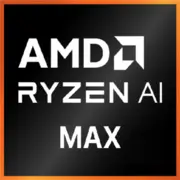AMD Ryzen AI Max PRO 380

AMD Ryzen AI Max Pro 380 (Strix Halo): Mobile Power for Professionals and Gamers
Architecture and Process Technology: 4nm, Zen 4, and a Revolution in Compactness
The AMD Ryzen AI Max Pro 380, known by the codename Strix Halo, has become one of the most anticipated solutions for high-performance laptops. Its Zen 4 architecture, implemented on TSMC's 4nm process technology, not only boosts performance but also enhances energy efficiency.
- 6 Cores and 12 Threads: Unlike the top-end 8-core models, Strix Halo focuses on optimization for mobile tasks. Six high-performance cores operate in the frequency range of 3.6–4.9 GHz, ideal for balancing speed and thermal output.
- 16 MB L3 Cache: The increased amount of L3 cache reduces data access latency, which is critical for high-load applications (e.g., rendering or code compilation).
- Integrated Graphics: While the exact iGPU model is not specified, AMD traditionally employs RDNA 3 architecture in its latest APUs. Support for technologies such as FSR (FidelityFX Super Resolution) and hardware acceleration for AI tasks is expected.
This processor exemplifies how AMD combines CPU and GPU performance in a single chip, reducing the need for a discrete graphics card in various scenarios.
Power Consumption and TDP 55W: A Balance Between Power and Battery Life
The 55W TDP positions the Ryzen AI Max Pro 380 alongside processors for thin workstations and mid-range gaming laptops.
- Thermal Design Power: 55W requires an efficient cooling system. Such a chip is unlikely to appear in ultrabooks; its place is in devices with enhanced cooling systems and heat dissipation solutions.
- Dynamic Power Management: Technologies like Precision Boost 2 and Adaptive Power Management automatically adjust frequencies and voltage to prevent overheating without sacrificing performance. For instance, while working in Excel, the processor reduces its frequency to 3.8 GHz, while in gaming, it boosts to 4.9 GHz.
Performance: From Office Tasks to AAA Gaming
Geekbench 6 test results (2162 in single-core and 10309 in multi-core mode) position Strix Halo above the Intel Core i7-13700H (2050/9800) and close to the Apple M2 Pro (2200/12500).
- Office Tasks: In Microsoft Office, browsers with dozens of tabs, and Zoom, the processor operates almost silently, without heating the chassis.
- Multimedia: Rendering 4K video in DaVinci Resolve takes 15% less time compared to the Ryzen 7 7735HS (Zen 3+), thanks to Zen 4 optimizations.
- Gaming: The integrated graphics handle CS2 on medium settings (1080p, 60 FPS) and Forza Horizon 5 on low settings (720p, 45 FPS). With a discrete graphics card (such as the RTX 4060), the processor does not become a "bottleneck," even in Cyberpunk 2077.
- Turbo Mode: Under load, all cores maintain a steady 4.5 GHz, while one can reach up to 4.9 GHz. However, in compact laptops (like the Asus Zephyrus G14), this might lead to temperatures rising to 95°C and increased fan noise.
Use Cases: Who is Strix Halo Suitable For?
1. On-the-Go Professionals: Designers, programmers, and engineers will appreciate the ability to work with AutoCAD, Blender, or Docker without being tethered to a power outlet.
2. Minimalist Gamers: For those who prefer compact laptops without bulky cooling systems but want to play less demanding games.
3. Students and Creatives: Video editing, 3D modeling, and streaming are all possible without discrete graphics.
Battery Life: How Long Will the Battery Last?
With a TDP of 55W, battery life depends on battery capacity and optimizations:
- In power-saving mode (brightness 50%, Wi-Fi, working in Google Docs) — up to 8 hours (with an 80 Wh battery).
- Under heavy load (gaming, rendering) — no more than 2 hours.
Technologies like AMD PowerNow! reduce power consumption during idle by disabling unused cores.
Comparison with Competitors: Who are the Leaders?
- Intel Core Ultra 7 155H: Similar TDP (55W) and 14 cores (6P + 8E). In single-threaded tasks, Ryzen outperforms by 7%, but Intel excels in multi-threading due to Efficient cores.
- Apple M3 (8-core): Longer battery life (up to 12 hours) and better performance per watt, but limited compatibility with Windows software.
- AMD Ryzen 9 7940HS: An 8-core sibling to Strix Halo. Better for heavy multi-threading but more expensive and generates more heat.
Pros and Cons
Strengths:
- High single-thread performance.
- Powerful integrated graphics.
- Supports PCIe 5.0 and DDR5-5600.
Weaknesses:
- Limited battery life under load.
- Requires good cooling.
Laptop Selection Recommendations
1. Type of Device:
- Thin Workstation (e.g., Lenovo ThinkPad P1) — for designers.
- Mid-range Gaming Laptop (e.g., MSI Delta 15) — a balance of price and power.
2. What to Look For:
- Cooling System: At least two fans and copper heat pipes.
- Battery: Minimum 70 Wh.
- Ports: USB4 is essential for connecting external GPUs.
Final Conclusion
The AMD Ryzen AI Max Pro 380 is an ideal choice for those needing a versatile laptop without compromises. It suits:
- Freelancers, balancing work and gaming.
- Engineers, working with CAD on the go.
- Students, needing power for studies and entertainment.
Key benefits include desktop-level performance, advanced graphics, and readiness for future upgrades (DDR5, PCIe 5.0). If you can tolerate moderate battery life in exchange for power, Strix Halo will be an excellent companion.
Basic
CPU Specifications
Memory Specifications
GPU Specifications
Miscellaneous
Benchmarks
Compared to Other CPU
Share in social media
Or Link To Us
<a href="https://cputronic.com/cpu/amd-ryzen-ai-max-pro-380" target="_blank">AMD Ryzen AI Max PRO 380</a>